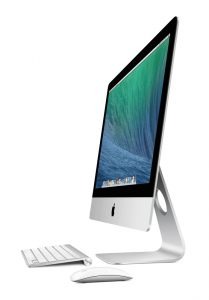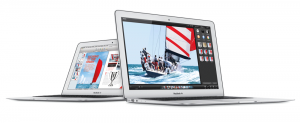 Apple recently announced a new $1099 version of the 21.5-inch iMac desktop computer system. This is roughly $200 less than the previous model and the release was likely timed to capture sales during the summer for the back-to-school shoppers. While the price drop is certainly nice and makes it more competitively priced against Windows based systems, I think it misses the mark in terms of the back-to-school crowd. While externally, the system looks no different than the other 21.5-inch iMac models, they made some pretty drastic changes to the internals in order to reduce the cost.
Apple recently announced a new $1099 version of the 21.5-inch iMac desktop computer system. This is roughly $200 less than the previous model and the release was likely timed to capture sales during the summer for the back-to-school shoppers. While the price drop is certainly nice and makes it more competitively priced against Windows based systems, I think it misses the mark in terms of the back-to-school crowd. While externally, the system looks no different than the other 21.5-inch iMac models, they made some pretty drastic changes to the internals in order to reduce the cost.
MacBook Air Crammed Into an iMac
 The big problem with the new iMac is that the internals have been swapped out from the standard desktop processors to the same mobile Core i5 processor that is used in the MacBook Air laptops. This is a major reduction in the overall performance of the system. Instead of having four cores, it now just has two and they run at roughly half the clock speed of the $1299 models quad-core desktop Core i5. At least it still features 8GB of memory rather than 4GB of the MacBook Air but OSX is very good at memory management that 4GB still runs many applications just fine.
The big problem with the new iMac is that the internals have been swapped out from the standard desktop processors to the same mobile Core i5 processor that is used in the MacBook Air laptops. This is a major reduction in the overall performance of the system. Instead of having four cores, it now just has two and they run at roughly half the clock speed of the $1299 models quad-core desktop Core i5. At least it still features 8GB of memory rather than 4GB of the MacBook Air but OSX is very good at memory management that 4GB still runs many applications just fine.
While the mobile Core i5 processor is just fine when it comes to basic computing tasks such as browsing the web, viewing or streaming digital media and using productivity applications, it is so far off when it comes to demanding tasks. Say for instance you want to edit a video shot on your phone for uploading to YouTube. Well, expect something like that to take almost twice as long than if you had a desktop class processor in it.
The other issue is that fact that you are essentially trading away portability of a MacBook Air for a larger display screen. Now it makes sense that you give up portability for performance but to basically sacrifice performance just for a larger screen does not make much sense. College students and even high school students now require the ability to take their computers with them. Being kept to a dorm room or a bedroom to do your computing tasks is just too restrictive in this day and age.
Another minor issue that the new iMac brings up is the fact that all of the internals are soldered onto the motherboard. This means that unlike the larger iMacs, there is even less that users can do to upgrade their computer systems. At least the rest of the iMac lineup has the ability to have the memory upgraded but the $1099 version is fixed at the 8GB. The reason this is a minor problem is that the majority of users do not have any need to upgrade the internals of their computer these days.
My Alternative Solution For Students
Now to match what the iMac offers, you need a extra storage space and a larger screen. The MacBook Air may have just 128GB of storage but that solid state drive makes the system actually faster than the iMac. A simple laptop class external hard drive that runs off of USB 3.0 can easily add the storage space. It is easy to find many drives that can run off a single USB port with 1TB of space for under $100. If you want even more space, you can easily go up to a 2TB drive that costs just over $100 and you have more storage than the base iMac but you will likely go over the equivalent price.
Now lets compare the options. The new iMac system costs $1099. If we buy a refurbished MacBook Air 13-inch ($799), a USB 3.0 1TB hard drive ($80) and a 24-inch monitor ($210) the final cost is $1089. That’s $10 cheaper than the new iMac system but we get a larger screen, faster performance from the solid state drive and the ability to use the computer outside of the home or dorm room. Of course, if you need performance, spend the extra $200 for the $1299 version of the iMac. The desktop quad core processor is a major step up when it comes to computing power. This is especially going to be important if you intend on using the computer for things like digital video work. Another option is to get a but even that will end up being over $1099.
